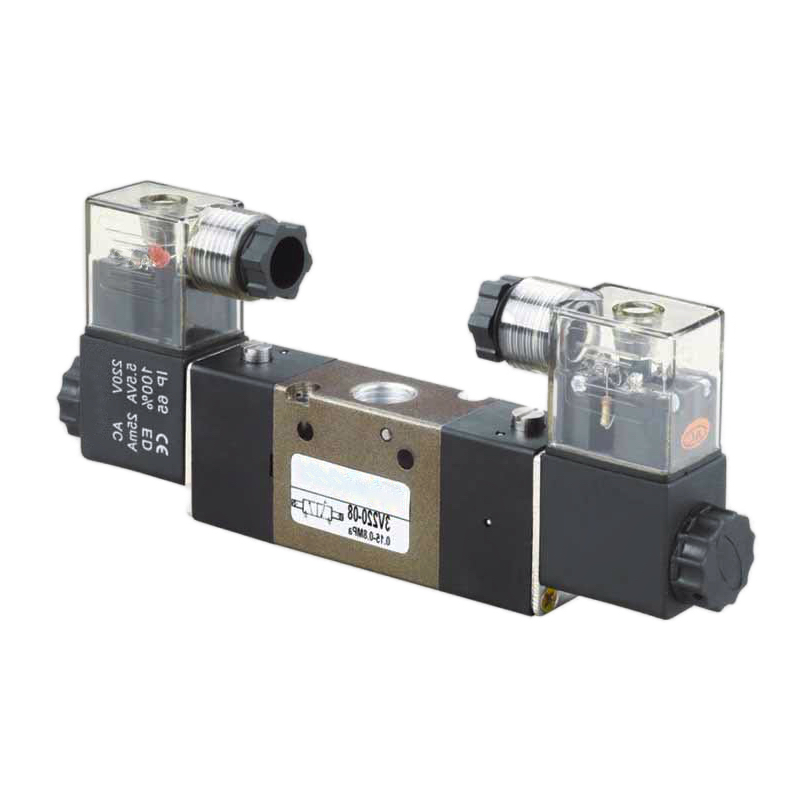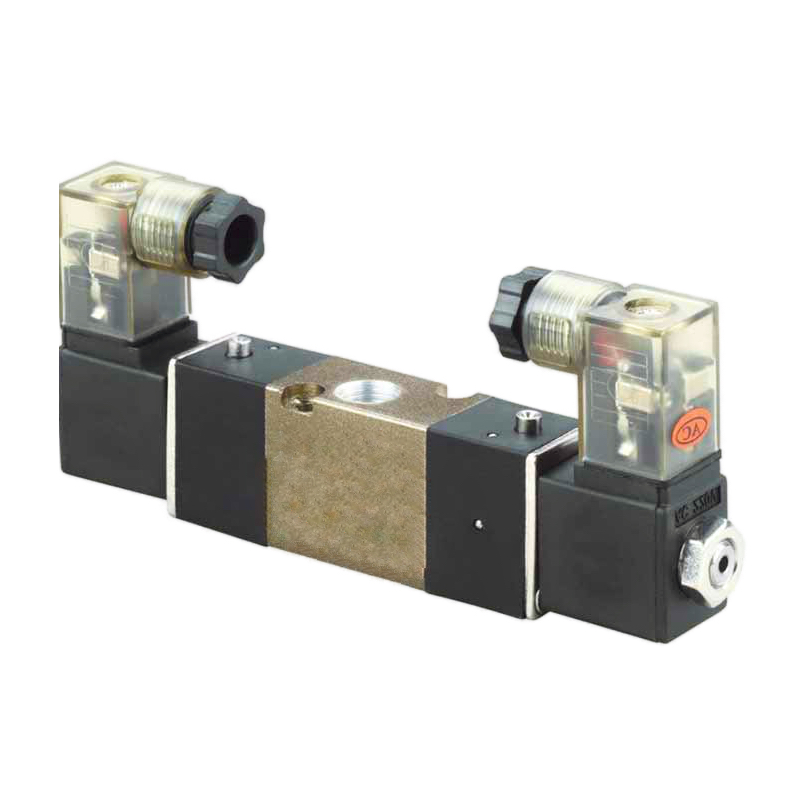When your automated production line operates inconsistently, costing you thousands in wasted materials and downtime, the culprit is often hiding in plain sight. Poor directional valve control doesn’t just affect one cylinder—it cascades through your entire pneumatic system, destroying precision and reliability.
4-way directional valve pneumatic control systems manage compressed air flow to double-acting cylinders1 by directing pressurized air to either cylinder chamber while simultaneously exhausting the opposite chamber, enabling precise bidirectional motion control in industrial automation applications.
Yesterday, I received a call from Marcus, a plant engineer at a textile manufacturing facility in North Carolina, whose packaging line was experiencing erratic cylinder movements that were rejecting 15% of products due to inconsistent positioning.
Table of Contents
- What Makes 4-Way Directional Valves Essential for Pneumatic Control?
- How Do Different 4-Way Valve Configurations Impact System Performance?
- Why Do Standard 4-Way Valves Fail in High-Speed Automation?
- Which 4-Way Valve Solutions Deliver Maximum Control Precision?
- FAQs About 4-Way Directional Valve Pneumatic Control Systems
What Makes 4-Way Directional Valves Essential for Pneumatic Control?
Modern automation demands precise, repeatable motion control, and 4-way directional valves are the traffic controllers of pneumatic systems.
4-way directional valves enable complete control over double-acting cylinder motion by simultaneously pressurizing one chamber while exhausting the other, providing the foundation for precise positioning, speed control, and force regulation in automated manufacturing processes.
The Heart of Pneumatic Automation
In my experience at Bepto, I’ve seen how proper valve selection transforms system performance. 4-way directional valves serve as the central nervous system of pneumatic control:
Core Functions
- Bidirectional Control: Enable extend and retract motions
- Pressure Distribution: Route compressed air efficiently
- Exhaust Management: Control decompression for smooth operation
- Safety Integration: Provide fail-safe positioning2 capabilities
System Performance Metrics
| Valve Quality | Response Time | Positioning Accuracy | Cycle Life | Energy Efficiency |
|---|---|---|---|---|
| Basic Valves | 50-100ms | ±2-5mm | 1-3 million | 65-75% |
| Standard Valves | 20-50ms | ±1-2mm | 3-8 million | 75-85% |
| Premium Valves | 5-20ms | ±0.5-1mm | 8-20 million | 85-95% |
Integration with Rodless Cylinders
4-way valves are particularly crucial for rodless cylinder applications, where precise control translates directly to product quality and throughput efficiency.
How Do Different 4-Way Valve Configurations Impact System Performance?
Understanding valve configurations helps optimize your pneumatic control system for specific automation requirements.
4-way directional valves come in various actuation methods including solenoid, pilot-operated, and manual configurations, with each offering distinct advantages for response time, flow capacity, power consumption, and integration complexity in control systems.
Actuation Methods Comparison
Direct-Acting Solenoid Valves
- Response Time: 10-30 milliseconds
- Flow Capacity: Limited to smaller port sizes
- Power Consumption: Higher electrical requirements
- Best For: High-speed, low-flow applications
Pilot-Operated Valves
- Response Time: 20-80 milliseconds
- Flow Capacity: Excellent for high-flow requirements
- Power Consumption: Lower electrical consumption
- Best For: Heavy-duty, high-flow applications
Servo-Assisted Valves
- Response Time: 5-15 milliseconds
- Flow Capacity: Variable flow control
- Power Consumption: Moderate with feedback systems
- Best For: Precision positioning applications
Port Configuration Options
| Configuration | Ports | Typical Application | Flow Characteristics |
|---|---|---|---|
| 4/2-Way | 4 ports, 2 positions | Basic extend/retract | On/off control |
| 4/3-Way | 4 ports, 3 positions | Hold position capability | Pressure/exhaust/block |
| 5/2-Way | 5 ports, 2 positions | Separate exhaust paths | Enhanced flow control |
| 5/3-Way | 5 ports, 3 positions | Complex motion profiles | Maximum flexibility |
Why Do Standard 4-Way Valves Fail in High-Speed Automation?
Cost-focused valve selection often becomes the bottleneck in high-performance automation systems, limiting overall productivity.
Standard 4-way valves typically feature basic spool designs, limited flow coefficients, and slower response times that create motion inconsistencies, pressure drops, and reduced cycle speeds in demanding industrial automation applications.
Common Performance Limitations
Through our valve upgrade projects, I’ve identified recurring issues with standard valves:
Flow Restrictions
- Undersized Ports: Create pressure drops at high speeds
- Basic Spool Geometry: Limits flow coefficient (Cv values)3
- Poor Exhaust Design: Causes back-pressure4 and slow retraction
Response Delays
- Heavy Moving Parts: Increase switching inertia
- Basic Pilot Systems: Add response lag
- Temperature Sensitivity: Affects viscosity and response
Real-World Case Study
Last month, I worked with Elena, who manages a robotic assembly line in Stuttgart, Germany. Her production targets required 120 cycles per minute, but her standard valves were limiting her to 85 cycles due to slow response times. After upgrading to our high-speed Bepto valve assemblies, she achieved 135 cycles per minute—exceeding her targets by 12.5% and increasing daily output by €8,000. 🚀
Cost of Valve Limitations
| Performance Issue | Production Impact | Annual Cost Impact |
|---|---|---|
| Slow Response | 15-25% cycle time increase | $45,000-$75,000 |
| Flow Restrictions | 10-20% speed reduction | $30,000-$60,000 |
| Inconsistent Positioning | 5-12% reject rate | $25,000-$85,000 |
Which 4-Way Valve Solutions Deliver Maximum Control Precision?
Advanced valve technologies provide the precision and reliability that modern automation demands while delivering measurable ROI.
High-performance 4-way directional valves featuring optimized flow paths, rapid response actuators, and integrated feedback systems deliver superior positioning accuracy, faster cycle times, and enhanced system reliability for demanding automation applications.
Bepto Advanced Valve Technologies
Our replacement and upgrade valve systems incorporate premium features often missing from standard designs:
Enhanced Flow Design
- Optimized Spool Geometry: 40% higher flow coefficients
- Larger Port Sizes: Reduced pressure drops
- Streamlined Exhaust Paths: Faster cylinder retraction
- Low-Friction Sealing: Improved response consistency
Smart Control Integration
- Position Feedback: Real-time valve position monitoring
- Pressure Sensing: Dynamic pressure compensation
- Flow Regulation: Integrated speed control capability
- Diagnostic Capabilities: Predictive maintenance alerts
Performance Upgrade Results
| Upgrade Category | Standard Performance | Bepto Enhanced | Improvement |
|---|---|---|---|
| Response Time | 45ms average | 12ms average | 73% faster |
| Flow Capacity | 850 L/min | 1,200 L/min | 41% increase |
| Positioning Accuracy | ±2.5mm | ±0.8mm | 68% improvement |
| Cycle Life | 5 million | 15 million | 200% longer |
ROI Through Valve Optimization
Our customers typically see immediate improvements:
- Throughput Increase: 15-30% faster cycle times
- Quality Improvement: 60-80% reduction in positioning errors
- Energy Savings: 20-25% lower compressed air consumption
- Maintenance Reduction: 50-70% fewer service interventions
The investment in premium valve technology typically pays back within 4-6 months through increased productivity and reduced operating costs. 💰
Conclusion
4-way directional valve pneumatic control systems are the precision instruments that transform basic compressed air into intelligent automation, and selecting the right valve technology directly determines your system’s performance ceiling and profitability.
FAQs About 4-Way Directional Valve Pneumatic Control Systems
How do I select the correct 4-way valve size for my application?
Valve sizing depends on cylinder bore diameter, required speed, operating pressure, and acceptable pressure drop, typically requiring flow coefficients 20-40% higher than calculated minimums. We use the formula: Required Cv = (Flow Rate × √Specific Gravity) / √Pressure Drop. Our technical team can perform detailed calculations based on your specific cylinder requirements and performance targets.
What causes 4-way valves to stick or respond slowly?
Valve sticking typically results from contamination buildup, inadequate lubrication, worn seals, or operating beyond temperature specifications, while slow response often indicates undersized pilot systems or electrical issues. Poor air quality with moisture or particles is the leading cause. We recommend installing proper filtration, regular lubrication, and monitoring electrical supply voltage for consistent performance.
Can I upgrade existing valve manifolds with higher-performance valves?
Most valve manifolds accept direct replacement valves with identical mounting patterns and port configurations, allowing performance upgrades without system redesign. Our Bepto replacement valves maintain standard ISO mounting dimensions while providing enhanced performance characteristics. We can cross-reference your existing setup and recommend compatible upgrades.
How do Pilot-Operated Valves compare to direct-acting valves for automation?
Pilot-operated valves offer higher flow capacity and lower power consumption but have slightly slower response times, while direct-acting valves provide faster response but are limited in flow capacity and require more electrical power. For high-speed, low-flow applications, direct-acting excels. For heavy-duty, high-flow requirements, pilot-operated valves are superior.
What maintenance schedule should I follow for 4-way directional valves?
Preventive maintenance should include monthly visual inspections, quarterly lubrication checks, semi-annual electrical connection verification, and annual complete service including seal replacement and internal cleaning. Operating conditions significantly affect intervals—contaminated environments may require more frequent service. We provide detailed maintenance protocols specific to each valve type and application.
-
See an animated guide explaining the internal workings and porting of a double-acting pneumatic cylinder. ↩
-
Explore examples of fail-safe circuit designs and their importance for safety in pneumatic systems. ↩
-
Access a technical guide on the flow coefficient (Cv) and how it is used to size pneumatic valves correctly. ↩
-
Learn what causes back-pressure in pneumatic exhaust lines and how it can negatively impact system performance. ↩





